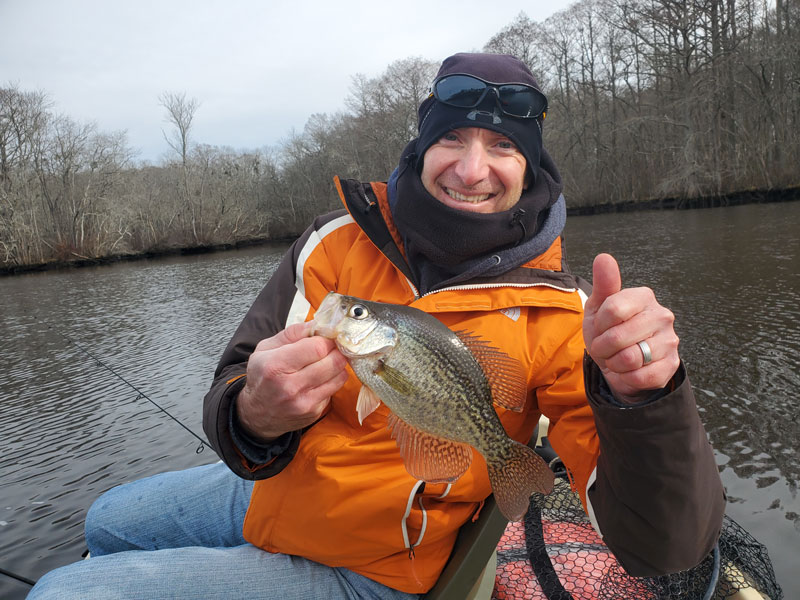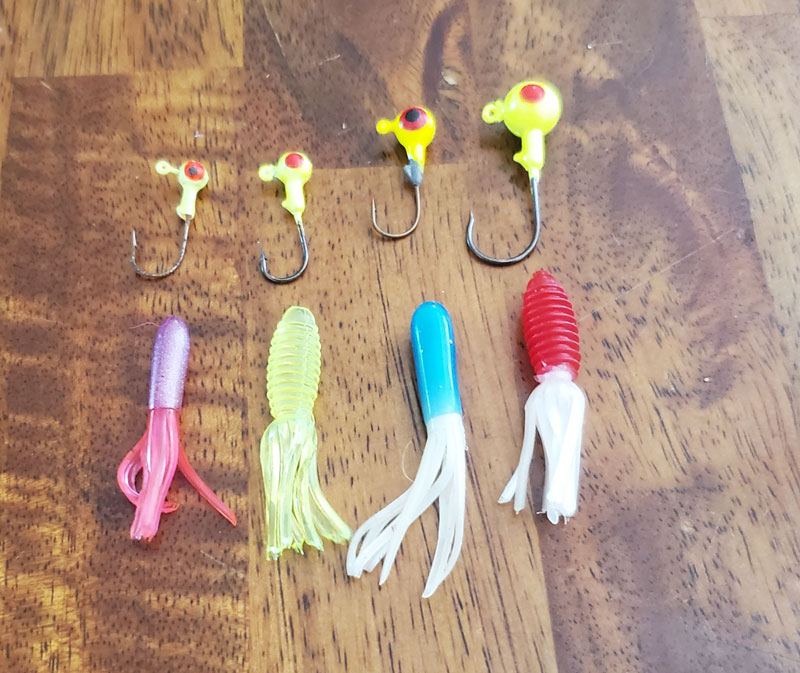Cold fronts are pushing through and a chill has crept into the air — in freshwater venues and upper tidal rivers throughout our corner of the world, crappie will be trying to pack on the pounds before winter sets in for real. The November bite can be the very best of the year for this species, and now’s your chance for awesome action whether you’d like to load the stringer with some fresh fish dinners, or go on a trophy hunt for some serious slabs.

Choosing the Best Tube Jigs for Crappie
This is prime time to try tube jigs, because these fish will be shifting off of shorelines and heading for mid-depth structure as the temperature drops. With a tube — which sinks better than a twister or a paddletail — you can rig up with jig heads from tiny split-shot sizes up to half of an ounce and cover every depth from two feet to 20. You can cast and retrieve them at structure. You can jig them vertically when positioned over the fish. You can fish them just about anywhere, any way, and those crappie are bound to pounce.
Focus on tubing and choose a leadhead sized for the depth those fish are currently holding at, and the most critical decision you’ll have to make is color choice. Note: crappie are notorious for switching their preference on a daily basis. One day color X is red hot, and the next it’s color Y. So you need to carry a wide assortment of tubes and once you locate the fish swap them out one after the next until you find the color and pattern they find tempting. That said, these are commonly the top producers listed in order of rank:
- Red/white
- Blue/white
- Chartreuse
- Black or purple (in muddy or discolored water)
What about size? As a rule, just about any size crappie will eat a two-inch tube and larger crappie don’t seem to be concerned about the bait’s diminutive nature. So, the vast majority of the tubes in your box should be two-inchers. But when the fish are very deep it may be necessary to jump to a three-inch bait just to match up with the necessarily larger jighead.

How to Fish Tube Jigs
Casting tubes for crappie is a game of finesse (we’ll get into the finer points in a moment) so you need very light or ultralight gear to make the magic happen. Six-pound setups are heavy but useable, and lighter is better. Rods should have fast-action for quick hooksets and must be uber-sensitive high-quality graphite. An example: for this type of fishing a great rig is a St. Croix Premier 6’0” light power fast action rated for four- to eight-pound test, with a Shimano Sahara FL spooled with five-pound Power Pro fishing line.
Spool up those micro-rigs with braid so you get maximum sensitivity and hook-setting power. You can tie your jighead directly to the braid (remember to use a Palomar knot since most others will slip) without fear of spooking the fish, because the crappie either don’t see it or don’t care and don’t have teeth sharp enough to chaff the line. However, if you’ll be fishing near an abrasive structure like concrete bridge pilings — which can be crappie magnets at this time of year — add a few feet of four- or six-pound fluoro for chaff-resistance.
One other piece of gear you’ll need is a landing net, whether you’re fishing from a boat, kayak, or shore. They don’t call these fish “papermouths” for nothing. With small crappie you can usually get away with swinging in the fish, but big ones are likely to fall off the hook so get ‘em in with a scoop.
Tips for Fishing Tubes
Now for those finer points: tubes don’t have much natural action, but when jigged all those tiny little legs produce an enticing wiggle. After casting to the fish-holding structure and allowing the tube to fall to the appropriate depth, get minimal tension on the line and give that lure a micro-jig by moving the rod tip up at a moderate rate just a foot or so. Don’t snap it too hard because a jig that zips up three feet at lightning speed will sometimes spook these fish. But it can’t be lazy, either; you need to give a hop approximating the speed of a worried-but-not-spastic minnow. Then, drop the tip and take in line simultaneously as the jig sinks to maintain tension. If slack gets in the line reel a bit faster and/or drop the tip a bit slower. Bottom line, these fish tend to take tubes rather gently and you must maintain some level of tension or you’ll miss the strike.
Crappie will almost always hit on the drop and as long as you maintain that tension you’ll feel a subtle, single tap. Whammo — set that hook instantaneously. Don’t worry about being overly aggressive, because the uber-light rod you’re using won’t be stiff enough to rip the hook out.
If that strike doesn’t come continue jigging as you bring the tube back to the boat, but don’t feel like it’s necessary to keep it up from the beginning of the cast to the end. These fish usually hold tight to structure and once your jig is 10 to 15 feet off the mark it isn’t likely to get hit. So if that tube gets halfway back without any takers, feel free to zip it in the rest of the way and take a fresh shot.
In certain scenarios, usually when the crappie are huddled around bridge pilings or standing timber in water of 12 or more feet, vertical jigging will prove more productive than casting and retrieving. In this case you’ll want to position yourself directly over the fish, drop the jig down to depth, and give one- to two-foot vertical jigs allowing it to freefall on the way down. Again, maintain some level of tension. In this scenario often you won’t feel a strike, especially if you drop your tip too quickly, but you’ll notice your jig stops falling short of the bottom. Did the bottom suddenly come up, even though you’re not moving? Nope! Set the hook, fast, because you have a fraction of a second before the fish realizes it’s chomped on plastic and spits the tube out.
Will other lures perform admirably when targeting this species? Sure they will. Tiny blade-baits, twisters, and marabous tipped with a minnow are all good choices. But it’s rare that anything beats tubes when it comes to catching crappie late in the fall.
Three Top Mid-Atlantic Fall Crappie Hotspots
To the North

Check out the small but pleasant Piney Run Lake in Sykesville, MD. Though it gets a lot of pressure during the summer the crowds are mostly gone by this time of year, and it has excellent launch facilities plus boat/kayak/canoe rentals (weekends only in November). Hot crappie zones include the brushpiles near the boardwalk to the right of the ramps (when facing the lake), the weedy upper section of the lake to the left of the ramps, and the underwater points off cove mouths.
In the Middle
St. Mary’s Lake between Leonardtown and Great Mills, MD. Although most of the fish here aren’t huge, the schools are vast. Launch facilities are great, and this lake is far enough from major population centers that even on weekends it’s rare to find a crowd here. There’s standing timber visible to the left of the ramp and across the lake in the big cove running north near the dam. Also try vertical jigging next to the spillway.
Lake Anna, north of Richmond, VA, has a healthy population of crappie including some true slabs. This is a large lake (13,000 acres) and there are a ton of options here, but the bridge pilings are known to be big-time crappie hotspots. Try pulling right up next to them, look for fish on the meter, drop to their depth, then vertically jig your tubes.
To the South
Sitting on the Virginia/North Carolina border, Kerr Reservoir (also called Buggs Island Lake) is a monster at 49,000 acres. This body of water is known for producing big crappie and lots of them. Again, the bridge pilings are key structure that the fish love to swarm by. They also stage at the drop-offs near creek mouths, as well as around the countless sunken Christmas trees planted by local anglers.
Crappie In the Weeds
If it’s been a mild fall thus far and there are weedbeds that haven’t died all the way back yet, try tying on 1/16- or 1/8-ounce heads and trolling your tubes over the weedbed at crawling speed. This can be particularly effective in the Eastern Shore millponds and other shallow waterways where weeds may provide the bulk of the structure.